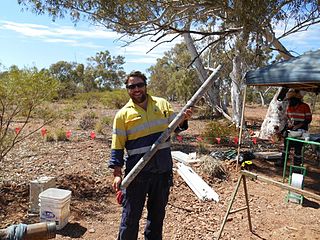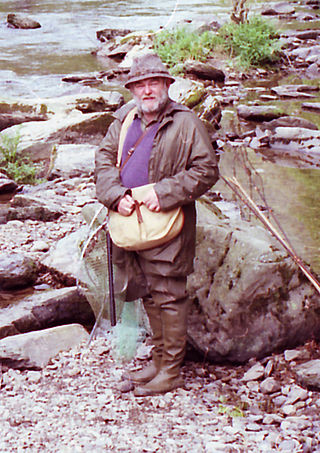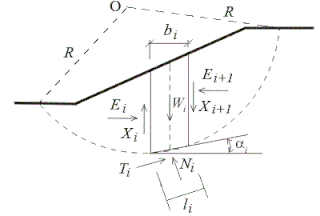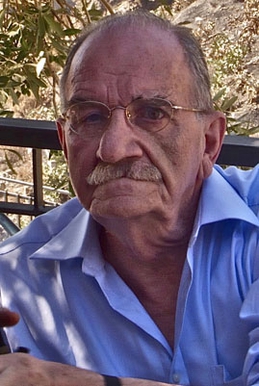Related Research Articles

Geotechnical engineering, also known as geotechnics, is the branch of civil engineering concerned with the engineering behavior of earth materials. It uses the principles of soil mechanics and rock mechanics to solve its engineering problems. It also relies on knowledge of geology, hydrology, geophysics, and other related sciences.

Engineering geology is the application of geology to engineering study for the purpose of assuring that the geological factors regarding the location, design, construction, operation and maintenance of engineering works are recognized and accounted for. Engineering geologists provide geological and geotechnical recommendations, analysis, and design associated with human development and various types of structures. The realm of the engineering geologist is essentially in the area of earth-structure interactions, or investigation of how the earth or earth processes impact human made structures and human activities.
Geomechanics is the study of the mechanical state of the Earth's crust and the processes occurring in it under the influence of natural physical factors. It involves the study of the mechanics of soil and rock.

Nathan Mortimore Newmark was an American structural engineer and academic, who is widely considered one of the founding fathers of earthquake engineering. He was awarded the National Medal of Science for engineering.
Ralph Brazelton Peck was a civil engineer specializing in soil mechanics, the author and co-author of popular soil mechanics and foundation engineering text books, and Professor Emeritus of Civil Engineering at the University of Illinois Urbana-Champaign. In 1948, together with Karl von Terzaghi, Peck published the book Soil Mechanics in Engineering Practice, an influential geotechnical engineering text which continues to be regularly cited and is now in a third edition.

Peter Rolfe Vaughan ACGI, DIC, FREng, FICE, FCGI, MASCE, FGS, was Emeritus Professor of Ground Engineering in the Geotechnics department of Imperial College London.

Slope stability analysis is a static or dynamic, analytical or empirical method to evaluate the stability of slopes of soil- and rock-fill dams, embankments, excavated slopes, and natural slopes in soil and rock. It is performed to assess the safe design of a human-made or natural slopes and the equilibrium conditions. Slope stability is the resistance of inclined surface to failure by sliding or collapsing. The main objectives of slope stability analysis are finding endangered areas, investigation of potential failure mechanisms, determination of the slope sensitivity to different triggering mechanisms, designing of optimal slopes with regard to safety, reliability and economics, and designing possible remedial measures, e.g. barriers and stabilization.
The Rankine lecture is an annual lecture organised by the British Geotechnical Association named after William John Macquorn Rankine, an early contributor to the theory of soil mechanics.

John Boscawen Burland is a geotechnical engineer, Emeritus Professor and Senior Research Investigator at the Department of Civil and Environmental Engineering of Imperial College London, and a noted expert in the field of soil mechanics.
Alan Wilfred Bishop was a British geotechnical engineer and academic, working at Imperial College London.

The Department of Civil and Environmental Engineering is the academic department at Imperial College London dedicated to civil engineering. It is located at the South Kensington Campus in London, along Imperial College Road. The department is currently a part of the college's Faculty of Engineering, which was formed in 2001 when Imperial College restructured. The department has consistently ranked within the top five on the QS World University Rankings in recent years.
Thomas Denis O’Rourke is an American educator, engineer and serves as the Thomas R. Biggs Professor of civil & environmental engineering at the Cornell University College of Engineering. O’Rourke took his Bachelor of Science in civil engineering at Cornell's engineering college in 1970 and his doctorate at the University of Illinois Urbana-Champaign in 1975.
Rudolph "Silas"Glossop was a British geotechnical engineer and mining engineer notable for his contributions to the field of engineering geology and soil mechanics. He was instrumental in founding Soil Mechanics Ltd. and the establishment of the peer-reviewed journal, Géotechnique. The Glossop Lecture at the Geological Society is named after him.
The Newmark's sliding block analysis method is an engineering that calculates permanent displacements of soil slopes during seismic loading. Newmark analysis does not calculate actual displacement, but rather is an index value that can be used to provide an indication of the structures likelihood of failure during a seismic event. It is also simply called Newmark's analysis or Sliding block method of slope stability analysis.
The Sarma method is a method used primarily to assess the stability of soil slopes under seismic conditions. Using appropriate assumptions the method can also be employed for static slope stability analysis. It was proposed by Sarada K. Sarma in the early 1970s as an improvement over the other conventional methods of analysis which had adopted numerous simplifying assumptions.

Geotechnical centrifuge modeling is a technique for testing physical scale models of geotechnical engineering systems such as natural and man-made slopes and earth retaining structures and building or bridge foundations.
David Malcolm Potts is a professor of Analytical Soil Mechanics at Imperial College London and the head of the Geotechnics Section at Imperial College. He has been a member of the academic staff at Imperial College since 1979, responsible for teaching the use of analytical methods in geomechanics and the design of slopes and earth retaining structures, both at undergraduate and postgraduate levels.

Nicholas Neocles Ambraseys FICE FREng was a Greek engineering seismologist. He was emeritus professor of engineering seismology and senior research fellow at Imperial College London. For many years Ambraseys was considered the leading figure and an authority in earthquake engineering and seismology in Europe.
Emmericus Carel Willem Adriaan "Wim" Geuze was a Dutch civil engineer who contributed to the development of soil mechanics, and the founding of the geotechnical engineering journal, Géotechnique. He was head of research at the Laboratorium voor Grondmechanica in Delft, and professor of soil mechanics at Delft University of Technology and the Rensselaer Polytechnic Institute.
Edward (Éamon) T. Hanrahan was an Irish civil engineer, Associate Professor of Civil Engineering, and Head of department in the School of Civil, Structural and Environmental Engineering at University College Dublin (UCD). Owing to his contributions to geotechnical engineering education and practice in Ireland, a biennial lecture at UCD's Geotechnical Society is named in his honour.
References
- ↑ Sarma, S. K. (1975). "Seismic stability of earth dams and embankments". Géotechnique. 25 (4): 743–761. doi:10.1680/geot.1975.25.4.743.
- ↑ Dimitri Papastamatiou
- ↑ Sarma S. K. (1968), Response characteristics and stability of earth dams during strong earthquakes. PhD Thesis, Imperial College, University of London
- ↑ Sarma S. K. (1973), Stability analysis of embankments and slopes. Geotechnique, 23, 423 - 433, ISSN 0016-8505
- ↑ Sarma S. K. (1975), Seismic stability of earth dams and embankments. Geotechnique, 25, 743 - 761, ISSN 0016-8505
- ↑ Sarma S. K. (1979), Stability analysis of embankments and slopes. Journal of Geotechnical Engineering, ASCE, 1979, 105, 1511 - 1524, ISSN 0093-6405
- ↑ Non-vertical slices using Sarma's method
- ↑ Advantages of using Sarma's method
- ↑ British Geotechnical Society Prize of the Institution of Civil Engineers (1967) jointly with Professor Ambraseys, for the paper "The response of earth dams to strong earthquakes"
- ↑ BESU Lectures Series Archived 2011-07-17 at the Wayback Machine
- ↑ 5th International Conference on Earthquake Engineering [ permanent dead link ]
- ↑ World Conference on Earthquake Engineering
- ↑ Can dogs really predict earthquakes?
- ↑ Haiti needs seismic-resistant buildings
- ↑ Expert reaction to the earthquake in Haiti